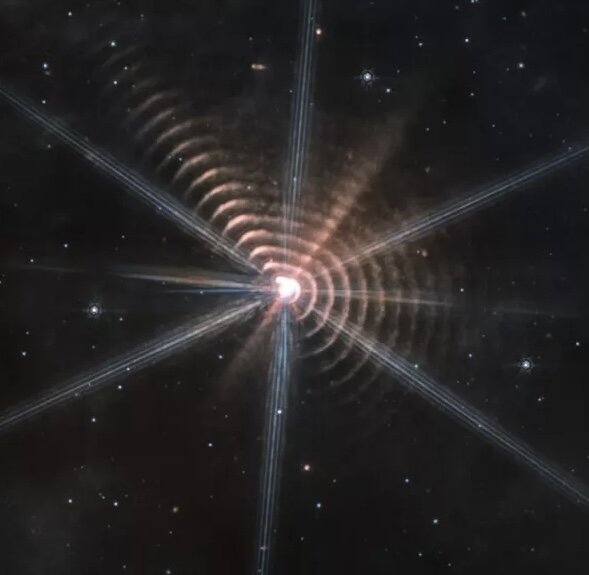This page is a permanent link to the reply below and its nested replies. See all post replies »
ElwoodBlues · M
I read an explanation of the concentric rings several days ago. Here's a copy-n-paste:


The object in question is a star around 5,600 light-years away, and Webb's infrared eye has picked out an extraordinary detail: it's surrounded by what appear to be concentric rings of light radiating outward.
While Webb's characteristic diffraction spikes are not 'real', those concentric rings are – and there's a wonderful and fascinating explanation for them.
The star is actually a binary pair of rare stars in the constellation of Cygnus, and their interactions produce precise periodic eruptions of dust that are expanding out in shells into the space around the pair over time.
These shells of dust are glowing in infrared, which has allowed an instrument as sensitive as Webb's MIRI to resolve them in exquisite detail.
The star is what is known as a colliding wind binary, consisting of an extremely rare Wolf-Rayet star, called WR 140, and a hot, massive O-type star companion – another rare object.
Wolf-Rayet stars are very hot, very luminous, and very old; at the end of their main-sequence lifespan. They are significantly depleted in hydrogen, rich in nitrogen or carbon, and losing mass at a very high rate.
O-type stars are among the most massive stars known, also very hot and bright; because they are so massive, their lifespans are incredibly brief.
Both stars in the WR 140 system have fast stellar winds, blowing out into space at around 3,000 kilometers (1,864 miles) per second. Both are therefore losing mass at a pretty furious rate. So far so normal, for both stars.
Where it gets interesting is their orbit, which is elliptical. This means the stars don't describe nice, neat circles around each other, but ovals, with a point at which they are farthest apart from each other (apastron) and a point at which they are closest to each other (periastron).
When the two stars enter periastron – a distance about a third greater than the distance between Earth and the Sun – they become close enough that their powerful winds collide.
This produces shocks in the material around the stars, accelerating particles and generating energetic radiation, such as X-rays. These colliding winds also induce episodes of dust formation as the material in the colliding stellar wind cools.
https://www.sciencealert.com/extraordinary-phenomenon-in-space-captured-by-spellbinding-new-imageWhile Webb's characteristic diffraction spikes are not 'real', those concentric rings are – and there's a wonderful and fascinating explanation for them.
The star is actually a binary pair of rare stars in the constellation of Cygnus, and their interactions produce precise periodic eruptions of dust that are expanding out in shells into the space around the pair over time.
These shells of dust are glowing in infrared, which has allowed an instrument as sensitive as Webb's MIRI to resolve them in exquisite detail.
The star is what is known as a colliding wind binary, consisting of an extremely rare Wolf-Rayet star, called WR 140, and a hot, massive O-type star companion – another rare object.
Wolf-Rayet stars are very hot, very luminous, and very old; at the end of their main-sequence lifespan. They are significantly depleted in hydrogen, rich in nitrogen or carbon, and losing mass at a very high rate.
O-type stars are among the most massive stars known, also very hot and bright; because they are so massive, their lifespans are incredibly brief.
Both stars in the WR 140 system have fast stellar winds, blowing out into space at around 3,000 kilometers (1,864 miles) per second. Both are therefore losing mass at a pretty furious rate. So far so normal, for both stars.
Where it gets interesting is their orbit, which is elliptical. This means the stars don't describe nice, neat circles around each other, but ovals, with a point at which they are farthest apart from each other (apastron) and a point at which they are closest to each other (periastron).
When the two stars enter periastron – a distance about a third greater than the distance between Earth and the Sun – they become close enough that their powerful winds collide.
This produces shocks in the material around the stars, accelerating particles and generating energetic radiation, such as X-rays. These colliding winds also induce episodes of dust formation as the material in the colliding stellar wind cools.
@ElwoodBlues thats so cool!!!!!! Thanks for finding that for us elwood :)
LeopoldBloom · M
@ElwoodBlues Fascinating graphic of the two objects rotating around their barycenter. The earth and moon do the same thing, but since the barycenter is inside the earth, it's not as noticeable.
ElwoodBlues · M
@LeopoldBloom Pluto & Charon rotate about a point outside both of them (one of the excuses they used to eject Pluto from the official planets) but their orbits are pretty circular. I don't know the mechanism (tidal forces??), but I believe orbits tend to become more circular over time.
So this object is kind a triple unicorn - two rare types of stars (double unicorn) in a unicorn orbit.
So this object is kind a triple unicorn - two rare types of stars (double unicorn) in a unicorn orbit.






